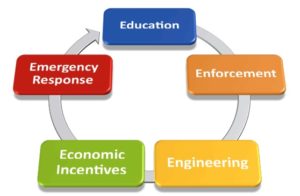Are You Crazy?
“Don’t change Fire Prevention to Community Risk Reduction!” I am one of the most vocal proponents of Community Risk Reduction. Many people feel I’m crazy and wrong about making this statement. I have been told, “At least CRR is being talked about” and “This change moves the focus in a positive direction onto Community Risk Reduction.” While I see their point. I see a much bigger issue that hurts the Community Risk Reduction cause.
Money, Power, Staffing, & Leadership
The Operations section of our Fire Departments have, and always will have, the most money, power, & staffing. Top leadership within our departments rarely comes from anywhere other than Operations. Some may have spent time in Fire Prevention, but their hearts are still rooted in Operations. Operations personnel typically dwarf Fire Prevention personnel in numbers. Union Leadership and initiatives are focused on Fire Operations, not Prevention. Politicians, when seeking support, point to Operations. At times, Fire Prevention represents a stumbling block to their campaign. These issues have been the case since the beginning of the fire service.
I Love My Fire Prevention Brothers and Sisters
Anyone who has ever spoken with me in person, read one of my articles, or heard me speak at a conference knows, though I come from Operations, I have the utmost respect and love for my Fire Prevention brothers and sisters. I understand their frustrations. I wish they could have the resources they need to accomplish their mission. I mean no disrespect to any in this worthwhile and necessary profession. We need and love you. That being said, we need to understand where the money, power, staffing, and leadership rests within our organizations if we are to move Fire Prevention and CRR to the forefront.
Whose Responsibility is Community Risk Reduction?
Here’s the problem with labeling Fire Prevention as Community Risk Reduction. We automatically place the responsibility for CRR on Fire Prevention and not the larger, better staffed, better funded, more politically active, majority of the department in Fire Operations. It is far too easy for Operations personnel to say, “CRR, that’s Fire Prevention’s job.” In all sincerity, the Fire Chief is the CRR Chief, not the Fire Marshal or parts of their staff. We all recognize that Emergency Response is one of the E’s of Community Risk Reduction. Why do we continue to exclude them by changing the name of Fire Prevention to Community Risk Reduction?

Fire Prevention is Part of CRR, just as Fire Operations is Part of CRR!
Fire Prevention is only part of Community Risk Reduction. We will always need those whose primary responsibility is plan checks, inspections, and the myriad of other Fire Prevention responsibilities. Because we change the name to Community Risk Reduction does not change their job responsibility, Fire Prevention. Those who are Fire Educators will not change their job responsibilities because we place them under CRR. The same goes for Fire Operations. If we place Fire Operations under CRR, that doesn’t change our primary responsibility either.
Community Risk Reduction Chief
Do I think Fire Chiefs across the world will be changing their titles to Community Risk Reduction Chief? I’m not that naive and I’m not sure that is the best solution either. The public knows us as Fire Departments or Fire and Rescue. They know that when they call, we show up. Let’s not lose that trust by confusing them with a name change. That being said, it may be appropriate to have another chief that oversees Operations and Prevention have the CRR Chief title. Would that send a clear message that Operations has a role in Community Risk Reduction?
One Big Happy Community Risk Reduction Family!

Every member of the fire service has a role in Community Risk Reduction. This includes the Fire Chief, Administrative Assistants, Fire Prevention, Volunteers, Fire Administration, Cadets, Explorers, Fire Educators, and yes even Fire Operations. Don’t exclude the other members of your department by simply changing the name of Fire Prevention to Community Risk Reduction. Use all of the Money, Power, Staffing, and Leadership of our organizations. We need to be “One Big Happy Family” if we are to move our Community Risk Reduction processes and programs forward.
 Brent Faulkner MAM, FO is the CEO of Virtual CRR Inc. He has 22 years of experience in the fire service. He has also served on a Type 1 Hazardous Materials Response Team for 16 years.
Brent Faulkner MAM, FO is the CEO of Virtual CRR Inc. He has 22 years of experience in the fire service. He has also served on a Type 1 Hazardous Materials Response Team for 16 years.
Brent had a defining moment in his career which, as a result, lead him to create Virtual CRR. This also fueled his passion for Community Risk Reduction. He led a team in critical infrastructure protection (CIP) at a recognized Department of Homeland Security (DHS) Terrorism Fusion Center. This team was responsible for increasing the safety of critical infrastructure. Especially as it relates to terrorism, general security, and natural disasters. He has a master’s degree in management and a bachelor’s degree in occupational studies. He also has an associate’s degree in hazardous materials response, and another in fire science.

